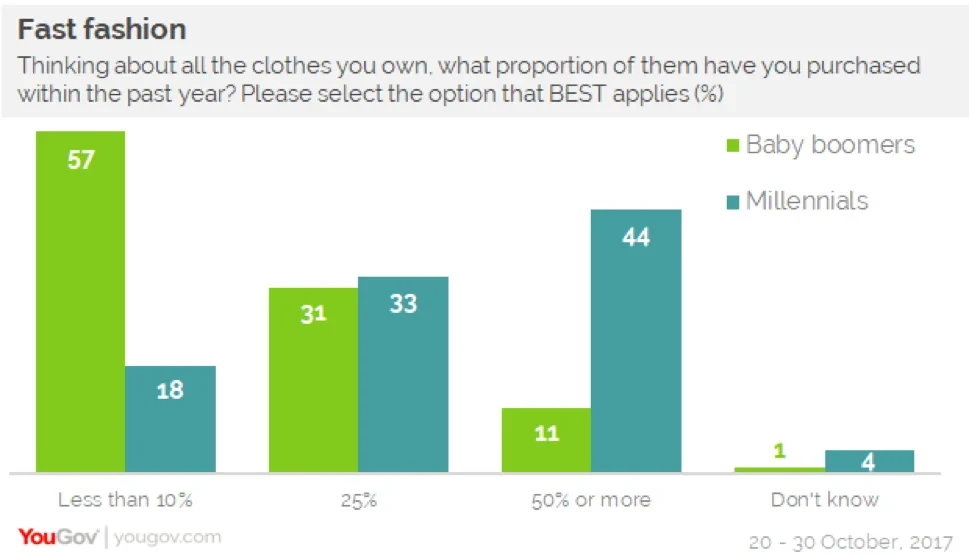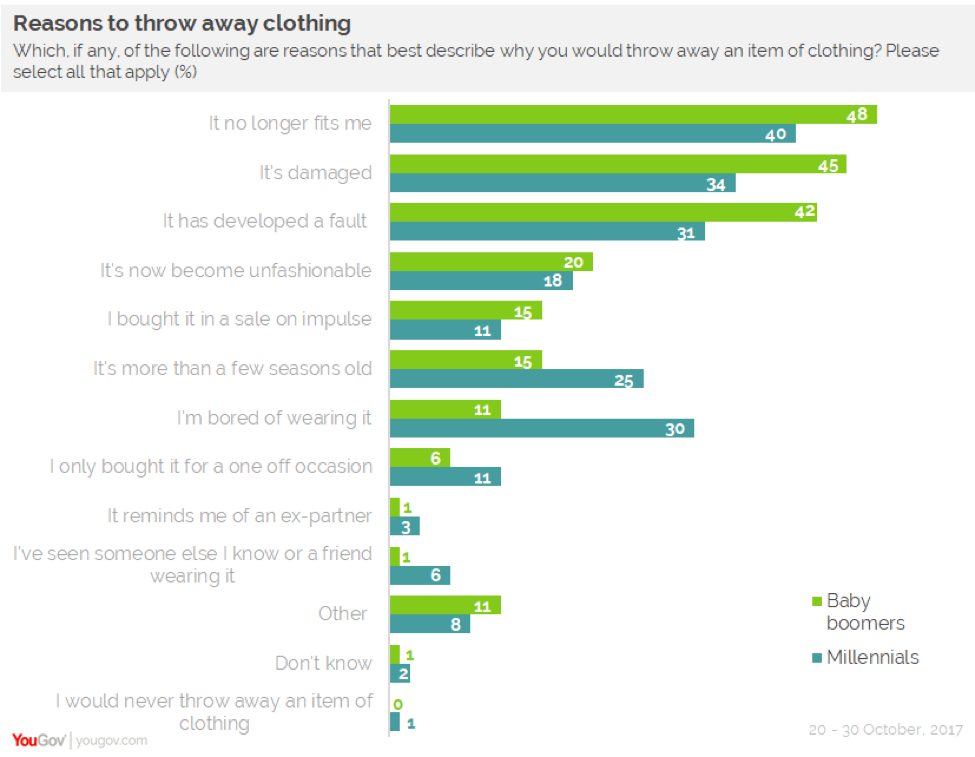
Fast fashion: 40% of Thais have thrown away clothing after wearing it just once
New YouGov research also reveals one in five millennials keep their clothes for under a year before throwing them away
Fast fashion has transformed the way we shop. The advent of more accessible and affordable fashion means that consumers are shopping more than ever before. The number of garments bought by the average shopper each year grew by 60% between 2000 and 2014 alone. With new lines added on a weekly basis, consumers no longer need to wait for the seasons to change to buy the latest trends. High street chains have come to dominate the market, so much so that fast fashion giant H&M is now twice as valuable as Chanel.
While many welcome the fashion revolution, accidents such as the Rana Plaza tragedy and accusations of exploitation have embroiled popular brands such as Zara, leading to questions over the industry’s ethics. Critics have also highlighted the impact that fast fashion brands have on the environment, fueling demand for cheap, disposable clothing that is carbon-intensive to produce and often ends up in landfill.
The latest YouGov Omnibus research reveals the extent of clothes waste in Thailand. It finds that eight in ten Thai adults (77%) have thrown clothes away at some point in the past year and four in ten (40%) have thrown away more than ten items of clothing in the past year.
The same proportion (40%) have thrown away an item of clothing after wearing it just once and, in the past year alone, a quarter of all respondents (25%) have thrown away at least three items that they’ve only worn once.
44% of millennials have purchased at least half of the clothes that they own in the past 12 months
Fashion is big business in Thailand, with nearly one in five of those polled (18%) estimating that they own over 100 garments (excluding underwear or accessories). Millennials (those aged between 16 and 34) have the highest proportion of new clothing; 44% of millennials say they have purchased at least half of the clothes that they own in the past year alone. This compares with 11% of baby boomers (those over 55) that say the same.


Millennials are also more likely to throw away clothes than older generations. One in five millennials (20%) say that, in general, they keep their clothes for under a year before throwing them away. Just 6% of baby boomers say the same.
Nearly one in five (17%) have thrown unwanted clothes in the bin
Generations also dispose of unwanted clothes through different means. While baby boomers are more likely to give their clothes to charity (82% of boomers have done this, compared with 62% of millennials) or recycle them (29%, compared with 20%), whereas millennials are more likely to sell them online (17% of millennials do this compared with 2% of boomers) or throw them in the bin (7% of millennials versus 4% of boomers).
Across all generations, nearly one in five (17%) have thrown unwanted clothes in the bin.
A third of millennials have thrown away clothes because they are bored of wearing them
The most popular reason for disposing of clothes is because they no longer fit, which 45% consider grounds for throwing garments away. Other common reasons to throw clothes away are because they have developed a fault (selected by 37% of respondents) and because they’re damaged (chosen by 37%).
However, millennials are less likely than baby boomers to throw away clothes for these reasons (see below chart), perhaps because they keep their clothes for less time than their elders, meaning they have less time to develop faults and damage over time.
Instead, millennials are more likely to throw away clothes because their tastes change. Nearly twice as many millennials have thrown out clothes because it’s “more than a few seasons old” (25% compared with 15% of boomers). Similarly, a third of millennials (30%) have thrown away clothes because they are “bored of wearing it”, whereas just 11% of boomers have done the same.

YouGov’s Head of Omnibus, Jake Gammon, comments. “Fast fashion brands have been keen to remove their unsustainable label. Yet despite various recycling initiatives by leading labels, this survey highlights just how many clothes go to waste each year in Thailand. Looking ahead to the future, there is a worrying trend among millennials; their propensity to dispose of clothing at a faster rate and using less sustainable means than older generations suggests that there is an uphill battle ahead.”
The bigger picture
At a regional level, Vietnamese and Chinese consumers are the most likely to keep clothes for under a year before throwing them away, where 27% and 23% do so (respectively). By contrast, Australians, Hong Kongers and Singaporeans are the least likely to keep their clothes for under a year – just 4%, 6% and 6% (respectively) say the same.
However, Thais are the most likely to have thrown away more than three items of clothing in the past year that they have only worn once (17% have done so), whereas Chinese consumers are the least likely (8% have done so). On the other end of the scale, as many as 25% of Filipinos, 21% of Malaysians and 21%of Indonesians have not thrown away any items of clothing in the past year.
*Data was collected online by YouGov Omnibus between 20 and 30 October 2017 among 1,137 respondents in Thailand. Results are representative of the adult online population.
Photo source: Getty Image